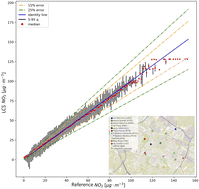Evaluation of low-cost gas sensors to quantify intra-urban variability of atmospheric pollutants†
Abstract
Low-cost air quality monitoring units were tested within the context of the European research project TRAFAIR. This study aims to quantify the intra-urban variability of atmospheric pollutants by means of a low-cost sensor network, which was deployed across the urban area of Modena, in the Po Valley (Italy) for the assessment of air quality in the city. Each sensor unit featured a set of electrochemical cells responding to NO, NO2 and O3 delivering a current/voltage proportional to the mixing ratio of the target atmospheric pollutant. Each unit was calibrated using field colocation next to an urban regulatory air quality monitoring station in the city. A machine learning Random Forest algorithm was used as a calibration model and different configurations of the model were applied. The results from these configurations were compared in terms of their prediction performance and consistency of the explanatory variable role within the model. A significant variability in all pollutants across town was revealed by the units, highlighting areas impacted by local sources.

- This article is part of the themed collection: A collection on dense networks and low-cost sensors, including work presented at ASIC 2022


 Please wait while we load your content...
Please wait while we load your content...